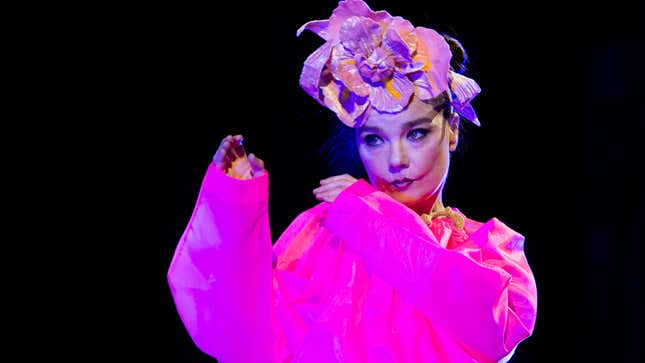Björk Is Inviting Us into Her Creative Process With One Hell of a Podcast
"I want to be all the Smurfs. You know, like, that's my rebellion," says the Icelandic star on an episode of Sonic Symbolism.
EntertainmentMusic

During the height of her pop-star era, back in the first half of the ‘90s, there were days when Björk would do interview after interview. “Sometimes it was, like, insane,” she recalls on the podcast she just launched, Sonic Symbolism. She felt a “genuine merge” with each journalist, she explains, and put her heart into each discussion. “It was kinda like, oh, now I’m gonna be like the extroverts, but kind of knowing that I was pushing an introvert machine to 11,” she says. “And then I had to, like, withdraw straight after, but it was somehow like, I don’t know, proving to myself that I could do it. Or maybe you have to try everything once, kind of like [when] normal people go backpacking…in the Himalayas. That’s like their way of testing themselves.”
The Icelandic iconoclast may have slowed down her media machine, but she has retained her overachiever’s approach to fielding questions that is partly responsible for her quirky reputation. She shows that flair for vivid metaphors and surprising connections on Sonic Symbolism, which examines her solo career, with each episode devoted to a different album in her catalog. It’s such a joy to just hear her describe things. Her melodies are “like crooked trees…they’re kind of a little bit wild, you know, and also with a lot of space.” Post is her “promiscuous” album on account of its many collaborators and ensuing sounds. The beats on her 1997 masterpiece Homogenic are “volcanic.” When standing in front of a room of admires onstage, she reflects, “There’s a lot of electricity there and a lot of voltage—a lot, a lot of voltage.”
Flair or no flair, the Björk on Sonic Symbolism is for the most part subdued, clear, and adept at articulating the rationale behind her most alien of sounds. The podcast, a collaboration with Mailchimp Presents and Talkhouse, largely presents album-specific conversations between Björk and her friends Oddný Eir, a philosopher and writer, and musicologist Ásmundur Jónsson. In some ways, the podcast is the perfect medium for Björk’s brand of public speaking—here she isn’t edited down to just the funny parts, and in fact those funny parts (while often hilarious) seem less outlandish in the greater context in which they’re used to illustrate more grounded points. On the multivalent nature of 1993’s Debut, whose production Bjork describes as a “smorgasbord,” she says:
-

-

-

-

-

-

-

-

-

-

-

-

-

-

-

-

-

-

-

-

-

-

-

-

-

-

-

-

-

-

-

-

-

-

-

-

-

-

-

-








































